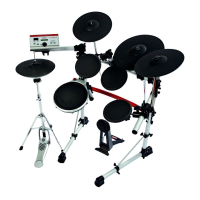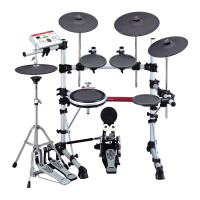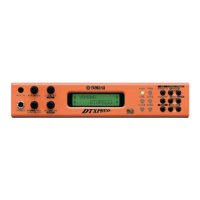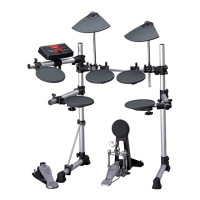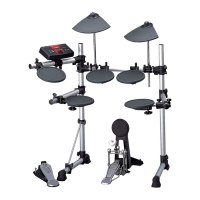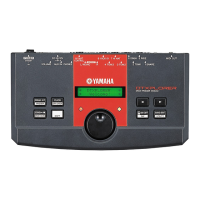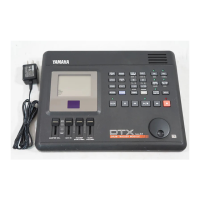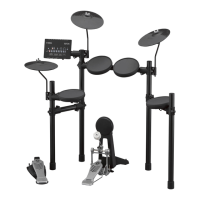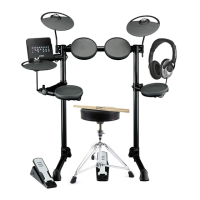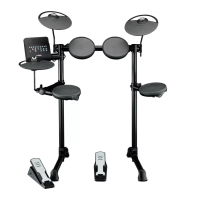Do you have a question about the Yamaha DTXPRESS III and is the answer not in the manual?
Diagram and explanation of the DTXPRESS III's signal flow from input to output.
Describes how trigger signals from pads are managed and processed by the DTXPRESS III.
Explains the mode for adjusting trigger input sensitivity, velocity curve, and cross-talk.
Details setting drum kit voices, tuning, and reverb level for each pad.
Instructions on how to access different operational modes like Drum Kit Play, Trigger Setup Edit, etc.
Explains how to move between pages within a mode using PAGE ▲/▼ buttons.
Describes using SEL ◀/▶ buttons to select parameters for editing.
Explains how to adjust parameter values using VALUE –/⁺ buttons.
Function for selecting and displaying the drum kit.
Function for selecting songs and setting playback tempo and beat.
Function for selecting the trigger setup.
Shows the Groove Check function's display elements: Groove, Average, and Graph.
Function for selecting and playing songs.
Sets the song to repeat playback continuously or normally.
Explains the structure of a song: header data and two sequencer tracks.
Differentiates between the main song played from the panel and pad songs triggered by pads.
Describes the metronome function and its settings.
Details how to select, start, stop, and control the main song playback.
How to play and stop pad songs, including setup requirements.
Covers volume control, metronome settings, count function, and MIDI control for playback.
Explains how to mute MIDI channels for drum parts during playback.
Details selecting User Song, setting recording conditions like measures, mode, and track.
Instructions on how to start, monitor, and stop the recording process.
How recording stops automatically or manually, and data backup caution.
Overview of the mode's capabilities: adjusting sensitivity and assigning voices.
Steps to enter the Trigger Setup Edit mode from the front panel.
Divides the mode into INPUT Parameters and COMMON Parameters.
Sets the type of pad or trigger sensor connected to an input jack.
Adjusts input sensitivity (gain) and minimum velocity for each input jack.
Prevents double triggers and cross talk for each input jack.
Prevents cross talk between two specified input jacks.
Sets data value for foot controller connected to HI HAT CONTROL jack.
Allows changing drum kit number by hitting a specified pad.
Overview of editing preset/user drum kits and storing changes.
Steps to enter the Drum Kit Voice Edit mode from the front panel.
Divides the mode into Voice Parameters, Input Common Parameters, Reverb Parameters, Setup, and Drum Kit Common Parameters.
Explains how to select the input source before editing voice parameters.
Defines various input sources like kick, snare, tom, etc. for trigger jacks.
Sets velocity cross fade between two layer voices.
Sets the reverb send level for each voice layer.
Sets alternate group and key assign mode for voices.
Sets the type of reverb effect and reverb time for each drum kit.
Sets the signal return level from the reverb effect for every drum kit.
Sets MIDI transmit channel, bank select MSB/LSB for transmitted data.
Sets MIDI control change volume and pan for transmitted data.
Copies drum kit voice settings from one input source to another.
Sets the overall volume for the drum voice.
Sets the overall reverb send level of the drum voice.
Sets foot controller sensitivity for the HI-HAT CONTROL jack.
Switches the main song when the drum kit is switched.
Changes the name of the currently selected drum kit.
Steps to enter the Song Edit mode from the front panel.
Lists the 9 pages within the Song Edit Mode.
Changes tempo and sets repeat playback for user songs.
Changes voices for each MIDI channel in the user song.
Steps to enter the Utility Mode from the front panel.
Lists the 6 sub-groups within the Utility Mode.
Contains settings for the DTXPRESS III's tone generator.
Contains settings affecting the entire DTXPRESS III system.
Contains settings for MIDI and TO HOST functions.
Contains settings for the DTXPRESS III's Click Voice functions.
Sets the Master Equalizer (2-band shelving type).
Allows muting of four instrument types: kick, snare, cymbal, and others.
Sets the master tuning of the tone generator.
Sets the overall volume level of the tone generator.
Decides whether to bypass the system effect's reverb or not.
Selects the pad/trigger input for editing in Trigger Setup or Drum Kit Edit modes.
Prohibits reception of pad signals from connected pads.
Sets how ACCOMP. VOL and CLICK VOL knobs control volume.
Displays the page last selected in previous edit modes.
Transmits stored DTXPRESS III data via MIDI OUT or TO HOST jack.
Replaces all internal settings with factory-set conditions.
Selects preset click voice sets or creates custom click voices.
Sets each of the 3 click voices used for the click sound.
Enables/disables transmitting/receiving system real-time messages.
Turns the 2-bar countdown before song playback ON or OFF.
Synchronizes the DTXPRESS III sequencer's clock with an external device.
Sets song tempo to change to default or remain unchanged when switched.
Creates a list assigning drum voices to MIDI note numbers.
Sets volume and pan for drum voices assigned to MIDI note numbers.
Sets the pitch for drum voices assigned to MIDI note numbers.
Lists categories of drum voices available on the DTXPRESS III.
Lists acoustic kick drum voices.
Lists acoustic snare drum voices.
Lists electric snare drum voices.
Lists acoustic tom drum voices.
Lists electric tom drum voices.
Lists cymbal voices.
Lists hi-hat voices.
Lists percussion voices.
Lists effect 1 voices.
Lists effect 2 voices.
Lists drum loop voices.
Lists miscellaneous voices.
Describes channel messages like Key On/Off, Control Change, Program Change, etc.
Details system exclusive messages like Parameter Change and Identify Request.
Details channel settings for MIDI communication.
Describes MIDI modes and their behavior.
Information on note number transmission and recognition.
Details velocity settings for note on/off messages.
Information on after touch messages.
Details pitch bender message transmission and recognition.
Information on control change messages.
Details program change message transmission and recognition.
Information on system exclusive messages.
System common messages like Song Position and Tune.
System real-time messages like Clock and Commands.
Auxiliary messages like All Sound Off and Active Sense.
Diagram and explanation of the DTXPRESS III's signal flow from input to output.
Describes how trigger signals from pads are managed and processed by the DTXPRESS III.
Explains the mode for adjusting trigger input sensitivity, velocity curve, and cross-talk.
Details setting drum kit voices, tuning, and reverb level for each pad.
Instructions on how to access different operational modes like Drum Kit Play, Trigger Setup Edit, etc.
Explains how to move between pages within a mode using PAGE ▲/▼ buttons.
Describes using SEL ◀/▶ buttons to select parameters for editing.
Explains how to adjust parameter values using VALUE –/⁺ buttons.
Function for selecting and displaying the drum kit.
Function for selecting songs and setting playback tempo and beat.
Function for selecting the trigger setup.
Shows the Groove Check function's display elements: Groove, Average, and Graph.
Function for selecting and playing songs.
Sets the song to repeat playback continuously or normally.
Explains the structure of a song: header data and two sequencer tracks.
Differentiates between the main song played from the panel and pad songs triggered by pads.
Describes the metronome function and its settings.
Details how to select, start, stop, and control the main song playback.
How to play and stop pad songs, including setup requirements.
Covers volume control, metronome settings, count function, and MIDI control for playback.
Explains how to mute MIDI channels for drum parts during playback.
Details selecting User Song, setting recording conditions like measures, mode, and track.
Instructions on how to start, monitor, and stop the recording process.
How recording stops automatically or manually, and data backup caution.
Overview of the mode's capabilities: adjusting sensitivity and assigning voices.
Steps to enter the Trigger Setup Edit mode from the front panel.
Divides the mode into INPUT Parameters and COMMON Parameters.
Sets the type of pad or trigger sensor connected to an input jack.
Adjusts input sensitivity (gain) and minimum velocity for each input jack.
Prevents double triggers and cross talk for each input jack.
Prevents cross talk between two specified input jacks.
Sets data value for foot controller connected to HI HAT CONTROL jack.
Allows changing drum kit number by hitting a specified pad.
Overview of editing preset/user drum kits and storing changes.
Steps to enter the Drum Kit Voice Edit mode from the front panel.
Divides the mode into Voice Parameters, Input Common Parameters, Reverb Parameters, Setup, and Drum Kit Common Parameters.
Explains how to select the input source before editing voice parameters.
Defines various input sources like kick, snare, tom, etc. for trigger jacks.
Sets velocity cross fade between two layer voices.
Sets the reverb send level for each voice layer.
Sets alternate group and key assign mode for voices.
Sets the type of reverb effect and reverb time for each drum kit.
Sets the signal return level from the reverb effect for every drum kit.
Sets MIDI transmit channel, bank select MSB/LSB for transmitted data.
Sets MIDI control change volume and pan for transmitted data.
Copies drum kit voice settings from one input source to another.
Sets the overall volume for the drum voice.
Sets the overall reverb send level of the drum voice.
Sets foot controller sensitivity for the HI-HAT CONTROL jack.
Switches the main song when the drum kit is switched.
Changes the name of the currently selected drum kit.
Steps to enter the Song Edit mode from the front panel.
Lists the 9 pages within the Song Edit Mode.
Changes tempo and sets repeat playback for user songs.
Changes voices for each MIDI channel in the user song.
Steps to enter the Utility Mode from the front panel.
Lists the 6 sub-groups within the Utility Mode.
Contains settings for the DTXPRESS III's tone generator.
Contains settings affecting the entire DTXPRESS III system.
Contains settings for MIDI and TO HOST functions.
Contains settings for the DTXPRESS III's Click Voice functions.
Sets the Master Equalizer (2-band shelving type).
Allows muting of four instrument types: kick, snare, cymbal, and others.
Sets the master tuning of the tone generator.
Sets the overall volume level of the tone generator.
Decides whether to bypass the system effect's reverb or not.
Selects the pad/trigger input for editing in Trigger Setup or Drum Kit Edit modes.
Prohibits reception of pad signals from connected pads.
Sets how ACCOMP. VOL and CLICK VOL knobs control volume.
Displays the page last selected in previous edit modes.
Transmits stored DTXPRESS III data via MIDI OUT or TO HOST jack.
Replaces all internal settings with factory-set conditions.
Selects preset click voice sets or creates custom click voices.
Sets each of the 3 click voices used for the click sound.
Enables/disables transmitting/receiving system real-time messages.
Turns the 2-bar countdown before song playback ON or OFF.
Synchronizes the DTXPRESS III sequencer's clock with an external device.
Sets song tempo to change to default or remain unchanged when switched.
Creates a list assigning drum voices to MIDI note numbers.
Sets volume and pan for drum voices assigned to MIDI note numbers.
Sets the pitch for drum voices assigned to MIDI note numbers.
Lists categories of drum voices available on the DTXPRESS III.
Lists acoustic kick drum voices.
Lists acoustic snare drum voices.
Lists electric snare drum voices.
Lists acoustic tom drum voices.
Lists electric tom drum voices.
Lists cymbal voices.
Lists hi-hat voices.
Lists percussion voices.
Lists effect 1 voices.
Lists effect 2 voices.
Lists drum loop voices.
Lists miscellaneous voices.
Describes channel messages like Key On/Off, Control Change, Program Change, etc.
Details system exclusive messages like Parameter Change and Identify Request.
Details channel settings for MIDI communication.
Describes MIDI modes and their behavior.
Information on note number transmission and recognition.
Details velocity settings for note on/off messages.
Information on after touch messages.
Details pitch bender message transmission and recognition.
Information on control change messages.
Details program change message transmission and recognition.
Information on system exclusive messages.
System common messages like Song Position and Tune.
System real-time messages like Clock and Commands.
Auxiliary messages like All Sound Off and Active Sense.
| Type | Electronic Drum Kit |
|---|---|
| Sound Module | DTXPRESS III |
| Sound Engine | AWM2 |
| Polyphony | 64 Voices |
| Presets | 50 |
| Sequencer | Yes |
| MIDI | In/Out |
| Power Supply | AC Adapter |
| Drum Kits | 50 |
| Effects | Reverb, EQ |
| Connectivity | USB, Audio Out |
| Dimensions | Varies by setup |
| Weight | Varies by setup |

